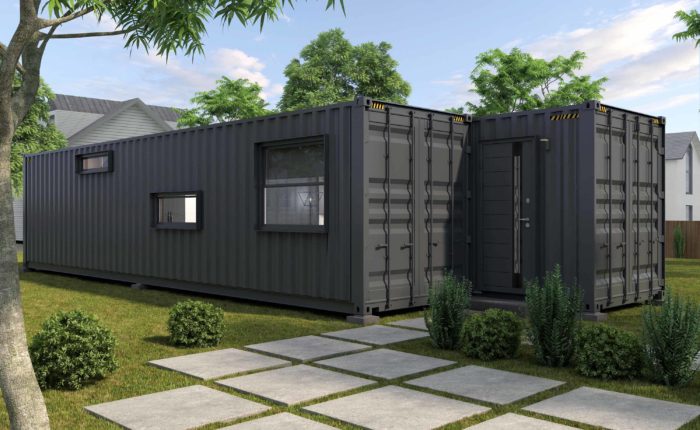Over three quarters of people in the UK live in urban settings. This is mostly because cities offer things that more rural areas may not such as career advancement and an exciting nightlife.
However, the sights and sounds of city life are also full of potential stress triggers. The constant hustle-and-bustle, noisy surroundings and the need to always be seen as up-to-date can have an increased impact on both the physical and mental health of many who live there.
This is why so many are eschewing the standards of city living for a more secluded life in the country. A life off grid represents a fresh start for anybody looking to reconnect with their true self and to rediscover nature.
At Live off Grid we create custom, purpose-built shipping container homes that are perfectly suited for your dream off grid lifestyle. Have you ever wondered how to convert a shipping container into a home in the UK? It’s an involved process, but here are a few important factors to keep in mind.
Converting a Shipping Container Into a House
The process of converting a shipping container into a house can be difficult, but intelligent planning allows you to live comfortably, sustainably, and happily off grid.
There are a series of key issues you must consider before beginning the undertaking of converting a shipping container into a home, these include:
- What is your budget?
- How will you plumb into your container?
- How do you plan to keep warm?
- Will you have electricity?
These issues and more can make or break a fledgling container conversion project, particularly for first-time convertors. This is why seeking expert help offers the best solution.
Cost of Converting a Shipping Container Into a Home
The cost involved in converting a shipping container into a home is a common stumbling block. Ultimately, the final cost will depend on what the specifications of your dream shipping container are, but common factors include:
- The price of the container
- Raw materials
- Land
- Labour
The cost of converting a shipping container home can quickly escalate. Mistakes can be common and often come with additional costs. Purchasing an unsuitable container or materials can cost thousands, and a mistake made during conversion could cost you both significant time and money.
To cut down on costs, you have to plan ahead. Try to minimise the chance for costly errors by conducting thorough research on any companies you hire to help and the materials you plan on using.
Alternatively, we can create a custom-built shipping container home for you. With prices starting from £41,999, you will save a great deal of time and money, and you have the added reassurance that your home will be constructed by experts.
How to Plumb a Shipping Container Home
Plumbing in a shipping container home can be daunting for anybody inexperienced in the process. The most important thing to remember is that you can save a lot of work, time, and money if you prepare early. This means allowing ample room for piping and preparing the area well in advance of installation.
The beauty of a shipping container home comes in its relative flexibility. Piping can be easily slipped through small holes in the floor/ceiling to connect any outlet you may need.
The specifics of how to plumb a shipping container home will depend on exactly how ‘off the grid’ you aim to go. If there is an available water supply nearby, if your container will be somewhere on your property, or near a settlement, then it can be plumbed in fairly simply. However, you can also opt for a water catchment tank if you want that truly off-grid, self-sustainable lifestyle.
Plumbing a shipping container home from scratch can be incredibly expensive, it could be more cost-effective to consider purchasing a container with this feature pre-built in.
How to Insulate a Shipping Container Home
While off grid living may appeal to many, the idea of living in what is ostensibly a metal box during extremely hot/cold weather may not have quite the same romanticism. This is why it is important that you understand how to insulate a shipping container home. There are multiple options available, including both conventional, and natural forms of insulation.
Different types of insulation for a shipping container home are:
- Blanket insulation: The most common type of insulation for homes, this form of insulation can also be suitable for shipping containers. You should make sure to check that the insulation is not made from fibreglass though, as this can be harmful in close proximity.
- Natural insulation: Similar in form and installation to blanket insulation, natural forms of insulation made from materials like wool, cotton, or cork are an environmentally friendly method of insulation that go hand in hand with a sustainable, off grid lifestyle.
- Spray foam: One of the most popular forms of insulation for shipping containers. Spray foam can create a perfect layer of insulation, limiting the potential for heat loss. It is highly effective, but is one of the costlier options.
- Insulation boards: Another popular choice. Insulation boards are ideal for a shipping container home because they are thin, while also insulating incredibly well despite the limited space needed. All of our containers are insulated with 50mm Kingspan insulation, widely considered industry standard for high quality homes.
Installing Electricity in a Shipping Container
Similar to plumbing, installing electricity in a shipping container can be incredibly complicated and highly expensive. It may be more cost-effective to consider purchasing a shipping container with these core features already factored in. There are several power options you can opt for such as:
- Mains
- Solar
- Wind power
- Hydro-electric
Conventional Mains Power
If your container home will be situated nearby to your main residence, or nearby a community, it may be possible to access power via the electrical grid. This simple solution allows unlimited access to an electrical supply, while potentially avoiding some of the difficulties of some of the alternative options.
The final connection into your container must be made by a certified electrician and surveyed by the electric company in order to ensure that all wiring is safe and compliant.
Alternative Power
If you’re looking to get off the grid in every sense of the word, alternative energy sources like solar, wind, and hydro-electric power can be an environmentally friendly, and a highly cost-effective method of installing electricity to your shipping container home.
For these sources of electricity to be workable for you, you will need to have your container in the right location. A container next to fast-flowing water could be ideal for hydro power, but less so if it is in the middle of an open field. The same can be said for wind turbines in the middle of a forest.
Solar power represents perhaps the most universally accessible source of power while remaining off the grid. It is cost effective, environmentally friendly, and allows you to accurately control your usage.
For solar power to be truly viable in the long term though, it is important that you consider investing in some way of storing power for when the sun is not shining. Batteries can be fairly expensive so it is important that you weigh up all the options before making a decision.
Creating a True Home That Works For You
Living off grid is a flexible way of life. A chance for you to leave the stresses of urban living behind and get back to nature. However, putting aside the stresses of the city and converting a shipping container into a house can bring with it a whole other set of stresses if not done carefully.
Your shipping container home should be unique to you, and every person looking to take up this lifestyle will have their own wants and needs. This means that every individual who begins the process of converting a container for themselves may come across new issues that need overcoming.
This is why a Live off Grid shipping container home represents the best of both worlds — an opportunity to get off the beaten path and return to nature, without needing to concern yourself with the burdens and labours that converting a container into a home can bring. Our shipping containers are purpose built exactly to your specifications and needs, without any hidden costs.
For more information please contact us at [email protected] today.



